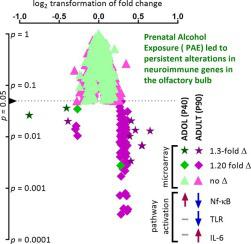Our official English website, www.x-mol.net, welcomes your
feedback! (Note: you will need to create a separate account there.)
Gene expression profiling reveals a lingering effect of prenatal alcohol exposure on inflammatory-related genes during adolescence and adulthood
Cytokine ( IF 3.7 ) Pub Date : 2020-09-01 , DOI: 10.1016/j.cyto.2020.155126 Anny Gano 1 , Laura Prestia 2 , Frank A Middleton 2 , Steven L Youngentob 3 , Cherry Ignacio 4 , Terrence Deak 1
Cytokine ( IF 3.7 ) Pub Date : 2020-09-01 , DOI: 10.1016/j.cyto.2020.155126 Anny Gano 1 , Laura Prestia 2 , Frank A Middleton 2 , Steven L Youngentob 3 , Cherry Ignacio 4 , Terrence Deak 1
Affiliation

|
Prenatal Alcohol Exposure (PAE) exerts devastating effects on the Central Nervous System (CNS), which vary as a function of both ethanol load and gestational age of exposure. A growing body of evidence suggests that alcohol exposure profoundly impacts a wide range of cytokines and other inflammation-related genes in the CNS. The olfactory system serves as a critical interface between infectious/inflammatory signals and other aspects of CNS function, and demonstrates long-lasting plasticity in response to alcohol exposure. We therefore utilized transcriptome profiling to identify gene expression patterns for immune-related gene families in the olfactory bulb of Long Evans rats. Pregnant dams received either an ad libitum liquid diet containing 35% daily calories from ethanol (ET), a pair-fed diet (PF) matched for caloric content, or free choice (FCL) access to the liquid diet and water from Gestational Day (GD) 11-20. Offspring were fostered to dams fed the FCL diet, weaned on P21, and then housed with same-sex littermates until mid-adolescence (P40) or young adulthood (P90). At the target ages of P40 or P90, offspring were euthanized via brief CO2 exposure and brains/blood were collected. Gene expression analysis was performed using a Rat Gene 1.0 ST Array (Affymetrix), and preliminary analyses focused on two moderately overlapping gene clusters, including all immune-related genes and those related to neuroinflammation. A total of 146 genes were significantly affected by prenatal Diet condition, whereas the factor of Age (P40 vs P90) revealed 998 genes significantly changed, and the interaction between Diet and Age yielded 162 significant genes. From this dataset, we applied a threshold of 1.3-fold change (30% increase or decrease in expression) for inclusion in later analyses. Findings indicated that in adolescents, few genes were altered by PAE, whereas adults displayed an increase of a wide range of gene upregulation as a result of PAE. Pathway analysis predicted an increase in Nf-κB activation in adolescence and a decrease in adulthood due to prenatal ethanol exposure, indicating age-specific and long-lasting alterations to immune signaling. These data may provide important insight into the relationship between immune-related signaling cascades and long-term changes in olfactory bulb function after PAE.
中文翻译:

基因表达谱揭示了产前酒精暴露对青春期和成年期炎症相关基因的挥之不去的影响
产前酒精暴露 (PAE) 对中枢神经系统 (CNS) 产生破坏性影响,其因乙醇负荷和暴露孕龄而异。越来越多的证据表明,酒精暴露会对 CNS 中的多种细胞因子和其他炎症相关基因产生深远的影响。嗅觉系统是感染/炎症信号与 CNS 功能其他方面之间的关键接口,并表现出对酒精暴露的持久可塑性。因此,我们利用转录组分析来鉴定 Long Evans 大鼠嗅球中免疫相关基因家族的基因表达模式。怀孕的母马接受含有 35% 每日卡路里乙醇 (ET) 的随意流质饮食、与卡路里含量匹配的配对喂养饮食 (PF)、或自由选择 (FCL) 从妊娠日 (GD) 11-20 获得流质饮食和水。后代被培育成喂食 FCL 饮食的水坝,在 P21 断奶,然后与同性同窝仔猪一起饲养,直到青春期中期 (P40) 或成年青年期 (P90)。在 P40 或 P90 的目标年龄,通过短暂的二氧化碳暴露对后代实施安乐死,并收集大脑/血液。使用 Rat Gene 1.0 ST Array (Affymetrix) 进行基因表达分析,初步分析侧重于两个适度重叠的基因簇,包括所有免疫相关基因和与神经炎症相关的基因。共有146个基因受到产前饮食状况的显着影响,而年龄因素(P40 vs P90)显示998个基因发生显着变化,饮食和年龄之间的相互作用产生了162个显着基因。从这个数据集,我们应用了 1.3 倍变化(表达增加或减少 30%)的阈值,以用于后续分析。研究结果表明,在青少年中,很少有基因被 PAE 改变,而成年人由于 PAE 表现出广泛的基因上调。通路分析预测,由于产前乙醇暴露,青春期 Nf-κB 活化增加,成年期减少,表明免疫信号的年龄特异性和长期改变。这些数据可能为 PAE 后免疫相关信号级联与嗅球功能长期变化之间的关系提供重要见解。而由于 PAE,成年人表现出广泛的基因上调增加。通路分析预测,由于产前乙醇暴露,青春期 Nf-κB 活化增加,成年期减少,表明免疫信号的年龄特异性和长期改变。这些数据可能为 PAE 后免疫相关信号级联与嗅球功能长期变化之间的关系提供重要见解。而由于 PAE,成年人表现出广泛的基因上调增加。通路分析预测,由于产前乙醇暴露,青春期 Nf-κB 活化增加,成年期减少,表明免疫信号的年龄特异性和长期改变。这些数据可能为 PAE 后免疫相关信号级联与嗅球功能长期变化之间的关系提供重要见解。
更新日期:2020-09-01
中文翻译:

基因表达谱揭示了产前酒精暴露对青春期和成年期炎症相关基因的挥之不去的影响
产前酒精暴露 (PAE) 对中枢神经系统 (CNS) 产生破坏性影响,其因乙醇负荷和暴露孕龄而异。越来越多的证据表明,酒精暴露会对 CNS 中的多种细胞因子和其他炎症相关基因产生深远的影响。嗅觉系统是感染/炎症信号与 CNS 功能其他方面之间的关键接口,并表现出对酒精暴露的持久可塑性。因此,我们利用转录组分析来鉴定 Long Evans 大鼠嗅球中免疫相关基因家族的基因表达模式。怀孕的母马接受含有 35% 每日卡路里乙醇 (ET) 的随意流质饮食、与卡路里含量匹配的配对喂养饮食 (PF)、或自由选择 (FCL) 从妊娠日 (GD) 11-20 获得流质饮食和水。后代被培育成喂食 FCL 饮食的水坝,在 P21 断奶,然后与同性同窝仔猪一起饲养,直到青春期中期 (P40) 或成年青年期 (P90)。在 P40 或 P90 的目标年龄,通过短暂的二氧化碳暴露对后代实施安乐死,并收集大脑/血液。使用 Rat Gene 1.0 ST Array (Affymetrix) 进行基因表达分析,初步分析侧重于两个适度重叠的基因簇,包括所有免疫相关基因和与神经炎症相关的基因。共有146个基因受到产前饮食状况的显着影响,而年龄因素(P40 vs P90)显示998个基因发生显着变化,饮食和年龄之间的相互作用产生了162个显着基因。从这个数据集,我们应用了 1.3 倍变化(表达增加或减少 30%)的阈值,以用于后续分析。研究结果表明,在青少年中,很少有基因被 PAE 改变,而成年人由于 PAE 表现出广泛的基因上调。通路分析预测,由于产前乙醇暴露,青春期 Nf-κB 活化增加,成年期减少,表明免疫信号的年龄特异性和长期改变。这些数据可能为 PAE 后免疫相关信号级联与嗅球功能长期变化之间的关系提供重要见解。而由于 PAE,成年人表现出广泛的基因上调增加。通路分析预测,由于产前乙醇暴露,青春期 Nf-κB 活化增加,成年期减少,表明免疫信号的年龄特异性和长期改变。这些数据可能为 PAE 后免疫相关信号级联与嗅球功能长期变化之间的关系提供重要见解。而由于 PAE,成年人表现出广泛的基因上调增加。通路分析预测,由于产前乙醇暴露,青春期 Nf-κB 活化增加,成年期减少,表明免疫信号的年龄特异性和长期改变。这些数据可能为 PAE 后免疫相关信号级联与嗅球功能长期变化之间的关系提供重要见解。











































 京公网安备 11010802027423号
京公网安备 11010802027423号